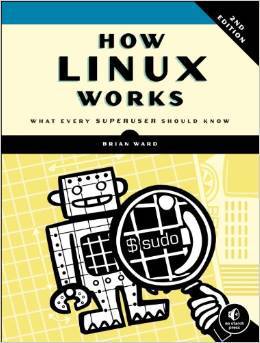Linux internal device or how Linux works

During the year, we published three books on Linux that were positively accepted:
Linux Installation, configuration, administration
Ubuntu and Debian Linux for advanced: more than 1000 irreplaceable commands. 2nd ed.
Linux System Programming. 2nd ed.
')
Now we are planning to make a new book and stop at the version - How Linux Works: What Every Superuser Should Know . We want to know your opinion and decide whether to make a book.
A small review of the past edition:
This book will introduce you to the internal organization of the Linux operating system. If you are a beginner (the book is perfectly written even for beginners), a programmer, a system administrator, a regular user or a researcher - however, if you are simply always interested in how this or that thing works, then this book is for you. For example, I am a programmer, I read it in order to learn more about Linux, since earlier my acquaintance with this system was limited to reading online manuals. The book is divided into three parts. Part 1 describes the general principles for the design and operation of Linux. The second part discusses programming tools available in Linux. The third part contains specialized topics, in particular, explains the work with the core, printing, etc.
Part 1: The basics are set out in great detail. I noticed that to clarify information on some of the commands discussed in this part, it is enough just to read the man or info help, but the author clearly intended the book differently. However, for reference, the author describes all the basic Linux commands and makes a brief introduction on each of them. The book is extremely simple language tells how exactly and on what principles work Linux file systems. For example, I was always confused about them, but after reading this book, I found out for myself all the nuances. In the course of studying the basics of Linux, we also get acquainted with the boot loaders of this operating system - GRUB and LILO. I note that the book is perfectly considered the network aspects of working in Linux. I can not comment on the part about ppp, but the topics of Ethernet, iptables and network address translation (NAT) are considered very well. Moreover, the author explains in detail how to ensure security in wireless networks.
Part 2. The second part begins with an introductory course on writing scripts for the shell (Shell scripting). However, it should again make a reservation about the target audience of this book - not all aspects of writing such scripts can be considered in such a small guide. The GCC and Make topics are explained very well (in essence, I figured out Make only by reading this book). Moreover, the scripts in this book are written in Python! Further, the author proceeds to the most interesting (for some, however, the most obnoxious) topic in Linux - kernel compilation. A whole chapter is devoted to working with the kernel. After reading it, I’m quite sure that I can recompile my system myself.
Part 3: This part can be read separately from the whole book. It covers specialized topics, each of which can be studied independently. For example, how to set up a network printer? How to work with CUPSd? How to use Ghostscript to convert Postscript to PDF? You will find answers to all these questions here. So, I just needed to learn how to work with the SAMBA file system. My home network consists of computers with Windows, and I occasionally had to refer to certain files located on them. Now everything has changed! I can easily browse all home directories directly from a laptop that connects to the network wirelessly.
Users often complain that many bugs arise in Linux when working with hardware. This book has an entire chapter on how to buy Linux compatible hardware. This material is very useful to you, especially if you are trying to equip your computer with the latest technology. In addition, this chapter will greatly assist system administrators engaged in servicing large corporate networks.
So, I recommend this book to all readers who are interested in the internal organization of Linux. You will find answers to all your questions and perfectly master all the mechanisms of Linux. Of course, after reading it you won’t become a Linux expert, but it will help you answer many “how” questions? and why"? In the future, it will serve as a solid basis for professional growth in the field of Linux.
Source: https://habr.com/ru/post/239311/
All Articles